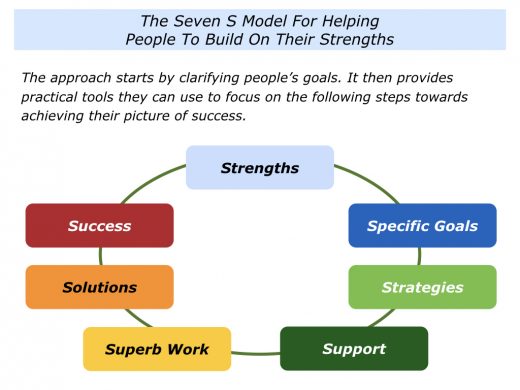
There are many models for helping people. The Seven S model is one that can be used to help people to build on their strengths and achieve their picture of success.
The model can be used with individuals, teams and organisations. It starts by setting the scene and clarifying people’s goals. It then provides practical tools they can use to achieve their aims.
Here is an introduction to the steps you can follow when working with an individual. We will then explore each of these in greater depth.
Setting The Scene
This involves creating a positive environment and clarifying the person’s picture of success.
Strengths
This involves focusing on their strengths and successful style.
Specific Goals
This involves focusing on their specific goals on the road to achieving their overall picture of success.
Strategies
This involves focusing on the key strategies they can follow to give themselves the greatest chance of success.
Support
This involves focusing on the support they need to help them to achieve their goals.
Superb Work
This involves focusing on how they can do superb work and, where appropriate, provide great service to customers.
Solutions
This involves focusing on finding creative solutions to challenges and overcoming setbacks.
Success
This involves focusing on the person doing whatever is required to achieve their picture of success.
The Strengths Approach
In Action
Imagine you work as a mentor and somebody has asked for your help. You will obviously prepare properly before the session. Here are some of the themes you may explore before the meeting. You will, of course, prepare in your own way.
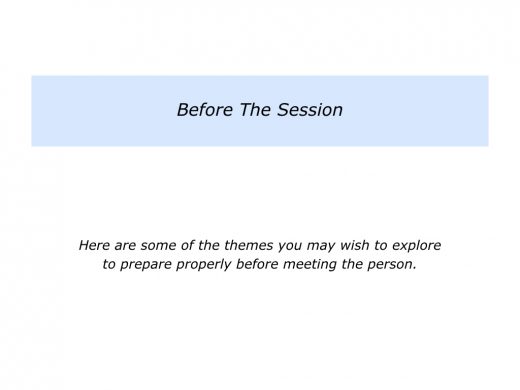
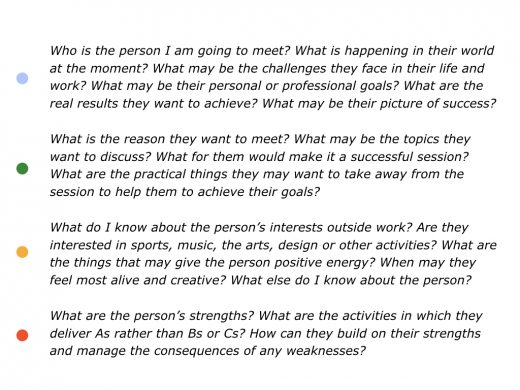
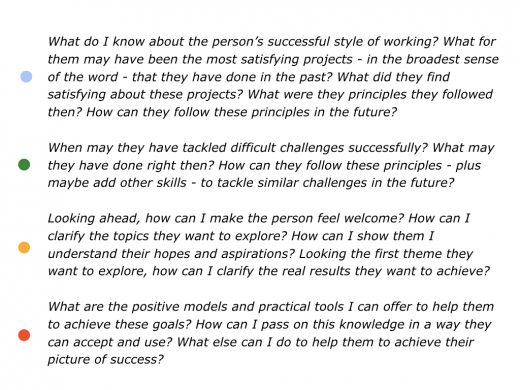
Setting the Scene
Imagine that you have prepared properly and it is time to meet the person. You will create an encouraging environment and clarify the topics they want to explore.
Here are some of the things you may want to say when clarifying the person’s agenda. You will, of course, do this in your own way.
Welcome to the session. As you know, we can focus on any topic that you would like to explore. We can look at how to tackle specific challenges or achieve your particular goals.
Once we have settled on the first topic, I will probably ask you lots of questions to build up the picture. Then, if is it okay by you, I will share some ideas and practical tools that you can use in your own way.
Let’s begin by seeing things in context. What is happening in your world at the moment? Are there any particular challenges that you face? Are there any particular goals that you would like to work towards?
Bearing these things in mind, which of these topics would you like to explore? For example:
How to …
How to …
How to …
Looking at these topics, which would you like to explore first? For example:
How to …
As I mentioned earlier, I will ask you some questions about this topic. We will then focus on how to achieve your goals. Is that okay?
Good mentors know their strengths and areas expertise. They also know those areas where they may need to advise the person to see another person or professional. So, after listening to the topics the person wants to explore, you may want to say something along the following lines.
Looking at the various topics you have outlined, I can offer ideas and practical tools on the following themes:
*
*
*
Looking at another of the themes you have mentioned, whilst I can offer ideas, I think it may be advisable to explore those with another person or professional.
Is that okay? Bearing that in mind, which is the first topic you want to explore?
You can, if you wish, immediately focus on the first topic. We will explore how to do this in Step Two: Specific Goals.
If it is the first time you are meeting the person, however, it may be worthwhile exploring their strengths. If so, you may want to say something along the following lines.
We will soon move on to exploring how you can work towards your goals and achieve your picture of success. If you wish, we can move straight onto that theme.
Before doing so, however, it may be useful to clarify your strengths. Is it okay to do that for a short while? We will then focus on how you can use your strengths to achieve your goals.
It is vital to do what works for the person. If they want to move straight on to tackling the first theme, then follow their wishes. At some point, however, it can be useful to know their strengths. You can then help them to build on these to achieve their aims.
Imagine that the person is happy to focus on their strengths. It can be appropriate to take this step before then moving back to focus on their specific goals.
Step 1: Strengths
There are many ways to find a person’s strengths and successful style. Some mentors use the strengths assessment tools. Another approach is to explore certain themes with the person.
If appropriate, you can do this by using some of the following questions to uncover their talents.
What are you strengths? What are the deeply satisfying activities in which you deliver As rather than Bs or Cs? When are you in your element – at ease and yet also able to excel? When do you experience a sense of flow?
What are the activities in which you see patterns? When do you quickly see the destination – the picture of success? When do you go ‘a, b … and then then leap to … z’? Which are the activities in which you are a good finisher?
Let’s explore your successful style. Looking back on your life, what for you have been the most satisfying projects? Looking at each project in turn, what made them satisfying? What were the principles you followed to do good work? How can you follow these principles in the future?
Step 2: Specific Goals
Bearing in mind the person’s strengths, you can return to the specific themes they want to explore in the session.
One key thing is worth bearing in mind at this point. Clarifying the person’s strengths often re-affirms their specific goals. But sometimes it can lead to revisiting and revising their plans.
Let’s imagine, however, that the person has returned to their original aims. It’s now important to set specific goals.
Clarity is crucial. It is important to ensure the person is crystal clear on the ‘What’ before moving to the ‘How’. So you may something like the following
Looking at the first theme to explore, what is your specific goal? What are the real results you want to achieve? What is your picture of success? What will be happening that will show you have reached your goal?
Let’s take a reality check before going any further. What are the things you can control in the situation? What can’t you control? How can you build on what you can control and manage what you can’t?
Bearing in mind the controllables, let’s go back to your goals. What are the real results you want to achieve?
The more specific the person is about their desired outcomes, the greater their chances of success. You can then move to the next step.
Step 3: Strategies
Good mentors help a person to clarify the ‘What’ – the real results to achieve – and then move on to the ‘How’. These are the key strategies the person can follow to give themselves the greatest chance of success.
There are many approaches to taking this step. One approach is to revisit their strengths. It is then clarify how they they can build on their strengths and follow their successful style to achieve their goals.
Another approach is to clarify the person’s possible choices for tackling the challenge and the consequences of each option. The person can then rate the attractiveness of each option on a scale 0 – 10. The overview of their potential options may look something like the following.
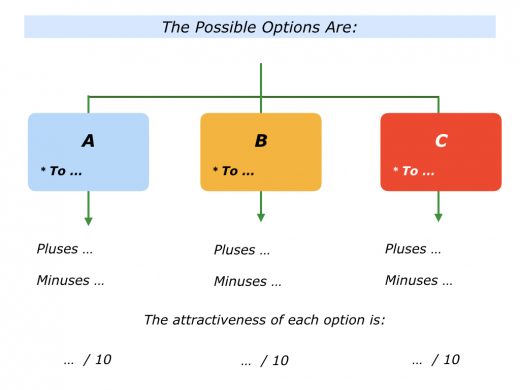
Imagine that you have helped the person to explore these themes. You may also have suggestions about how the person can achieve their aims. If so, you may then ask the person:
Is it okay if I share some ideas?
It is important to get the person’s psychological permission before you start sharing ideas. This means they will be more open to the suggestions that may help them reach their goals. The person will probably say:
Yes, I am open to any ideas.
You can then share knowledge, models and practical tools the person can use to achieve their picture of success. Look for the ideas that resonate with the person. You can then follow up these in more detail.
Every mentoring session is different, but at some point you may notice the person feels they have got enough ideas. You can then invite them to settle on their chosen way forwards by saying something along the following lines.
Looking at the results you want to achieve, what is the option – or the combination of options – you want to pursue?
What are the key strategies you can follow to give yourself the greatest chance of success? How can we translate these into a clear action plan?
It will then be time to move on to the next stage.
Step 4: Support
Even the toughest people need encouragement. You may therefore clarify what support the person may need by asking some of the following questions.
Looking at the strategies you are going to pursue, what support do you need to make them happen? What is the practical support? What is the psychological support?
Who are the people from whom you need support? How can you make clear contracts with these people? What is your back-up plan if you do not get the support?
How can you get some early successes? How can you encourage yourself on the journey? How can you manage your energy properly? How can create times for rest and recovery?
Good mentors ensure the person has built-in enough support. They may then move on to the next stage.
Step 5: Superb Work
It’s time to get the show on the road. You may therefore invite the person to explore some of the following questions.
How can you do superb work? How can you do your best to deliver success? How can you keep building on your strengths and managing the consequences of your weaknesses?
How can you do the right things in the right way every day? How can you be super professional? How can you always do the basics and then add the brilliance?
You can then continue to encourage the person on their journey. If appropriate, at some point you may also help them to deal with challenges.
Step 6: Solutions
Good mentors encourage people to anticipate and prevent difficulties. So you may ask them the following questions.
Looking ahead, what do you see as the potential difficulties? How can you prevent these difficulties happening? What can you do if, despite your efforts, these difficulties do occur?
However well the person prepares, they will still meet setbacks and difficulties. At these times you may work with them to find creative solutions to the challenges.
Different mentors use different models for helping people to find solutions. One approach is to use the 3 C Model which helps a person to focus on Clarity, Creativity and Concrete Results.
Here is an overview of the model. You can discover more about how to use it via the following link.
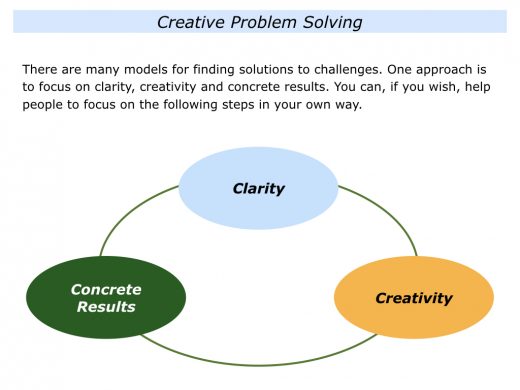
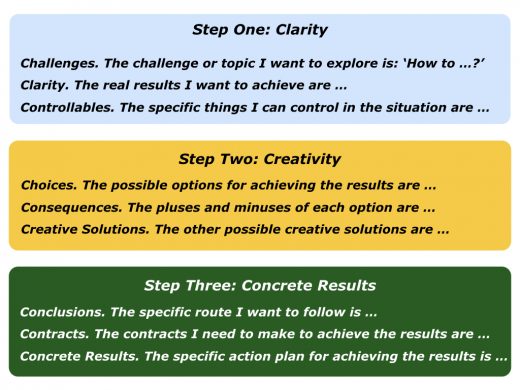
Imagine that you have helped a person to find solutions to challenges. It will then be time to move onto the final step.
Step 7: Success
Good mentors are often like good educators. They encourage, educate and enable people to achieve ongoing success. At the same time, the person must obviously work hard to reach their goals.
Let’s assume the person has made an action plan and embarked on the journey towards reaching their goals. You can then ask them some of the following questions.
What have been your early successes? What are you doing well? How can you do more of those things in the future? What can you do even better in the future – and how?
How can keep doing the right things every day? How can you encourage yourself on the journey? How can you manage your energy properly?
How can you relax, rehearse and rise to the occasion? How can you do whatever is necessary to reach your goals? How can you achieve peak performance? How can you add that touch of class?
As mentioned at the beginning, there are many models for helping a person to achieve their goals. This article has focused on how you can help them to build on their strengths.
As ever, take the ideas you like and use them in your own way. You can then continue to encourage and enable people to achieve their picture of success.
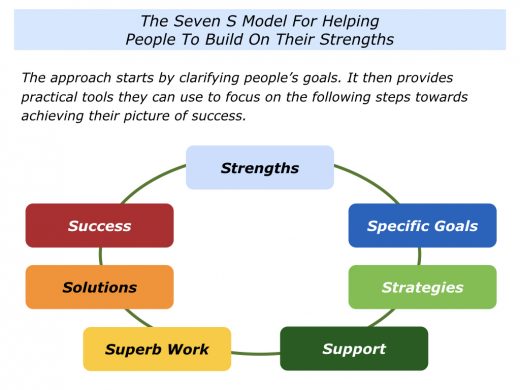






Leave a Reply